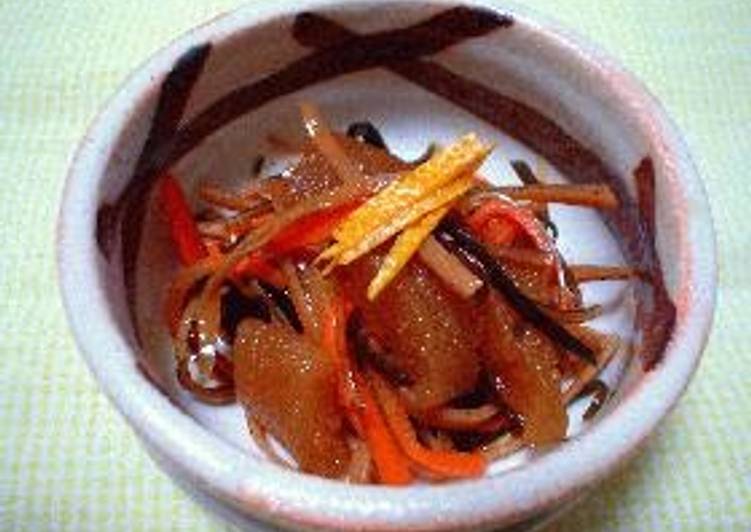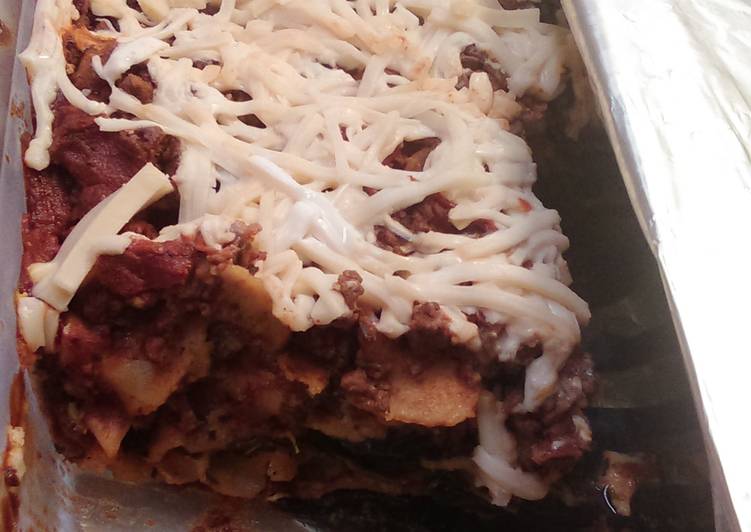
Hey everyone, it’s John, welcome to our recipe page. Today, I will show you a way to prepare a distinctive dish, pickled matsumae. One of my favorites. For mine, I’m gonna make it a little bit unique. This is gonna smell and look delicious.
Matsumaezuke (松前漬け) is a pickled dish native to Matsumae, Hokkaidō area of Hokkaidō, Japan. It is made from fresh ingredients of Hokkaidō. Surume (dried squid) and konbu are wiped with wet cloth and then cut into thin strips with scissors.
Pickled Matsumae is one of the most well liked of recent trending meals in the world. It’s simple, it’s quick, it tastes yummy. It is appreciated by millions every day. Pickled Matsumae is something which I’ve loved my entire life. They’re nice and they look wonderful.
To get started with this recipe, we have to first prepare a few components. You can cook pickled matsumae using 8 ingredients and 12 steps. Here is how you can achieve it.
The ingredients needed to make Pickled Matsumae:
- Prepare 2 pieces Dried squid
- Make ready 30 cm Kombu
- Make ready 1 small Carrot
- Take 6 small pieces Herring roe
- Take 133 ml ●Sake
- Prepare 133 ml ●Mirin
- Make ready 133 ml ●Soy sauce
- Take 1 Yuzu peel
Matsumae - I'm a boss and I know it. Koma Enji - Look how mighty I am! Kaya Irimi - Bet you weren't expecting a winged puppy, were ya? translation and definition "Matsumae pickles", Dictionary English-English online. Many translated example sentences containing "Matsumae pickles" - Japanese-English dictionary and search engine for Japanese translations.
Steps to make Pickled Matsumae:
- Use three times the amount of water for every 100 g of herring row with a small teaspoon of salt (not listed), and let soak for 2 hours changing the water 5-6 times. Lastly, peel the membrane from the roe.
- Lightly pat dry both sides of the dried squid with a rag that has been thoroughly rung out. (Cheap paper towels will leave behind lint, so they're no good).
- Cut off the legs, and cut off the hard parts from the trunk (you won't use them).
- Cut it up as finely as you possibly can with a pair of scissors as it'll expand later when cooking. If the squid is too tough, sprinkle with sake or soak completely to soften. Keep the leftover sake for later as we'll use it later.
- Lightly wipe the konbu seaweed with a rag, sprinkle with sake to soften, and julienne. If the konbu is too soft, it will be difficult to cut, so be careful.
- Finely chop the carrots as well.
- Add the • ingredients to a small saucepan, and bring to a boil.
- Wipe the water from the desalted herring roe, and cut into pieces.
- Place the squid cut into thin strips, the konbu, the carrots, and herring roe into a bowl along with the cooled Step 7, and mix.
- Let sit in the fridge, stirring it around from time to time (if you keep nibbling at it to test the flavor, it'll be gone before you know it). After it has softened and turned an amber color and the konbu has turned sticky, it's done.
- I garnished the dish with julienned yuzu peel for aroma.
- It is best to eat it within 5 days to 1 week.
Trouvez des images de stock de Matsumaezuke Pickled Kombu Dried Squid Carrot en HD et des millions d'autres photos, illustrations et images vectorielles de stock libres de droits dans la collection. Matsumaezuke is a pickled dish (native to Matsumae, Hokkaidō) made from surume (dried squid), konbu, kazunoko (herring roe), carrot and ginger with a mixture of sake, soy sauce and mirin. Marinated in dashi-infused vinegar, these Japanese-style Pickled Tomatoes make a refreshing side or appetizer to serve with your meal! Before the summer ends, I wanted to share one more recipe. The daughter of Matsumae Satsuki, the granddaughter of Shijima Sui, and the niece of Shijima Enishi.
So that’s going to wrap it up for this special food pickled matsumae recipe. Thank you very much for reading. I’m sure that you can make this at home. There’s gonna be more interesting food at home recipes coming up. Don’t forget to save this page in your browser, and share it to your family, colleague and friends. Thanks again for reading. Go on get cooking!


